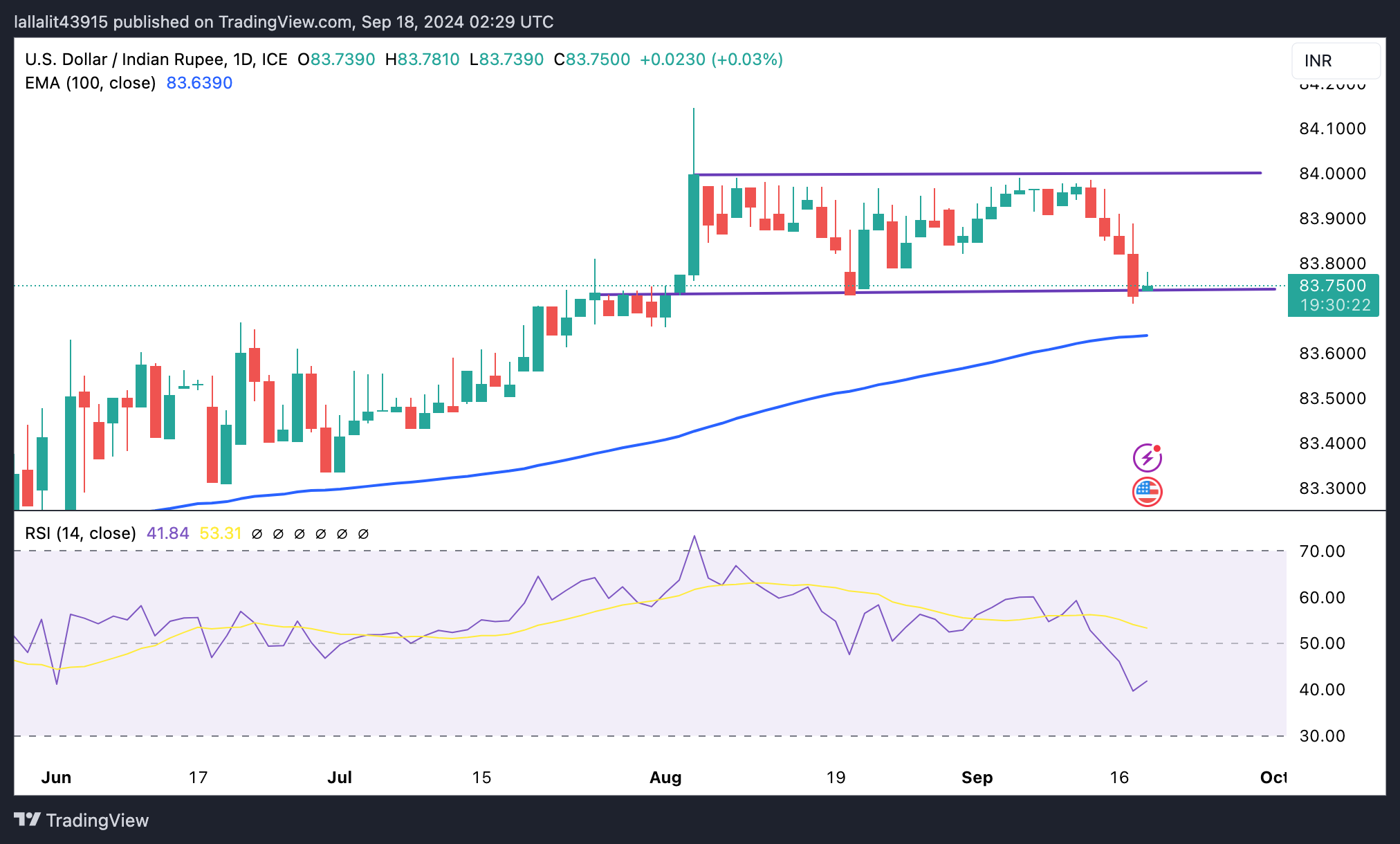USD/INR remains flat ahead of US Fed rate decision
- Indian Rupee holds steady in Wednesday’s Asian session.
- Firmer Fed rate cuts bets and robust USD sales weigh on the pair, but higher oil prices might cap its downside.
- The Fed rate decision will be in the spotlight on Wednesday.
The Indian Rupee (INR) trades on a flat note on Wednesday after climbing to a month-high of 83.75 in the previous session. The downtick of the pair is pressured by the rising expectations of a deeper Federal Reserve (Fed) rate cut and robust US Dollar sales. Nonetheless, the extended recovery of crude oil prices might undermine the local currency and help limit USD/INR losses.
Later on Wednesday, all eyes will be on the Fed interest rate decision, which is widely expected to cut the rate in its September meeting. Fed officials will also release a Summary of Economic Projections, or ‘dot-plot’ after the policy meeting, which could give insight into just how much the US central bank plans to cut over the next year. The expectation of the jumbo rate cuts might exert some selling pressure on the Greenback in the near term.
Daily Digest Market Movers: Indian Rupee flatlines ahead of US key event
- India's Wholesale Price Index (WPI)-based inflation declined to a four-month low of 1.31% YoY in August from 2.04% in the previous reading. This figure came in below the market consensus of 1.80%.
- India’s merchandise trade deficit stood at $29.65 billion in August compared with $23.5 billion in July, according to Ministry of Commerce and Industry data released on Tuesday.
- India's foreign exchange reserves rose to a record high of $689.2 billion as of September 6, according to the Reserve Bank of India (RBI).
- The US Retail Sales unexpectedly rose 0.1% MoM in August versus 1.1% prior, above the market consensus of -0.2%. Industrial Production climbed 0.8% MoM in August, compared to a decline of 0.6% in the previous reading, better than the estimation of 0.2%.
- According to the CME Fedwatch Tool, Fed funds futures have priced in nearly 63% probability of a 50 basis points (bps) rate cut, up from 30% a week ago, while the chance of a 25 bps cut was at 37%.
Technical Analysis: USD/INR’s positive outlook prevails in the longer term
The Indian Rupee trades flat on the day. The USD/INR pair oscillates within the rectangle on the daily chart. However, in the longer term, the pair keeps the bullish vibe as the price holds above the key 100-day Exponential Moving Average (EMA). Further downside cannot be ruled out as the 14-day Relative Strength Index (RSI) stands in the bearish zone below the midline, supporting the sellers for the time being.
The 83.90-84.00 zone appears to be a tough nut to crack for USD/INR buyers. This region portrays the upper boundary of the rectangle and psychological mark. A break above the mentioned level will see the next upside barrier at 84.50.
On the flip side, the initial support level is located at the low of September 17 at 83.70. A breach of this level will pave the way to the 100-day EMA at 83.64.

Indian Rupee FAQs
The Indian Rupee (INR) is one of the most sensitive currencies to external factors. The price of Crude Oil (the country is highly dependent on imported Oil), the value of the US Dollar – most trade is conducted in USD – and the level of foreign investment, are all influential. Direct intervention by the Reserve Bank of India (RBI) in FX markets to keep the exchange rate stable, as well as the level of interest rates set by the RBI, are further major influencing factors on the Rupee.
The Reserve Bank of India (RBI) actively intervenes in forex markets to maintain a stable exchange rate, to help facilitate trade. In addition, the RBI tries to maintain the inflation rate at its 4% target by adjusting interest rates. Higher interest rates usually strengthen the Rupee. This is due to the role of the ‘carry trade’ in which investors borrow in countries with lower interest rates so as to place their money in countries’ offering relatively higher interest rates and profit from the difference.
Macroeconomic factors that influence the value of the Rupee include inflation, interest rates, the economic growth rate (GDP), the balance of trade, and inflows from foreign investment. A higher growth rate can lead to more overseas investment, pushing up demand for the Rupee. A less negative balance of trade will eventually lead to a stronger Rupee. Higher interest rates, especially real rates (interest rates less inflation) are also positive for the Rupee. A risk-on environment can lead to greater inflows of Foreign Direct and Indirect Investment (FDI and FII), which also benefit the Rupee.
Higher inflation, particularly, if it is comparatively higher than India’s peers, is generally negative for the currency as it reflects devaluation through oversupply. Inflation also increases the cost of exports, leading to more Rupees being sold to purchase foreign imports, which is Rupee-negative. At the same time, higher inflation usually leads to the Reserve Bank of India (RBI) raising interest rates and this can be positive for the Rupee, due to increased demand from international investors. The opposite effect is true of lower inflation.



